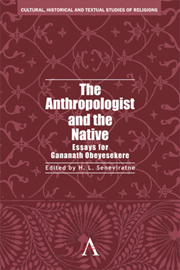Book contents
- Frontmatter
- Contents
- Editor's Note
- The Anthropologist and the Native: Essays for Gananath Obeyesekere
- SECTION I THE INDIAN TRADITION AND ITS REPRESENTATION
- SECTION II CASTE, KINSHIP, LAND AND COMMUNITY
- SECTION III RENUNCIATION AND POWER
- SECTION IV BUDDHISM TRANSFORMED
- SECTION V THE ENIGMA OF THE TEXT
- The Mythology of the Kāmasūtra
- Mandārampura Puvata: An Apocryphal Buddhist Chronicle
- Variants as Historical Statements: The Rāma-kathā in Early India
- SECTION VI THE ANTHROPOLOGIST AND THE NATIVE
- List of Contributors
The Mythology of the Kāmasūtra
from SECTION V - THE ENIGMA OF THE TEXT
Published online by Cambridge University Press: 05 May 2012
- Frontmatter
- Contents
- Editor's Note
- The Anthropologist and the Native: Essays for Gananath Obeyesekere
- SECTION I THE INDIAN TRADITION AND ITS REPRESENTATION
- SECTION II CASTE, KINSHIP, LAND AND COMMUNITY
- SECTION III RENUNCIATION AND POWER
- SECTION IV BUDDHISM TRANSFORMED
- SECTION V THE ENIGMA OF THE TEXT
- The Mythology of the Kāmasūtra
- Mandārampura Puvata: An Apocryphal Buddhist Chronicle
- Variants as Historical Statements: The Rāma-kathā in Early India
- SECTION VI THE ANTHROPOLOGIST AND THE NATIVE
- List of Contributors
Summary
The Kāmasūtra (KS), the classical Indian textbook of pleasure, is part of our Orientalist mythology of India, our own fantasy of the otherness of the sexuality of other cultures. Our fantasies are based in large part on the Victorian Orientalist fantasies of Sir Richard Francis Burton, who was the first to translate the Kāmasūtra into English, well over a century ago, in 1883. But the Kāmasūtra has a mythology of its own, a corpus of stories that it invokes to explain and to authenticate its ideas about sex and gender. Let us therefore begin with mythology about the Kāmasūtra and go on to the mythology in the Kāmasūtra.
Mythology about the Kāmasūtra
A man named Vātsyāyana composed the Kāmasūtra in Sanskrit, the literary language of ancient India, sometime in the third century of the common era, in North India. It was already well known in India at a time when the Europeans were still swinging in trees, culturally (and sexually) speaking, but it is known in English almost entirely through the translation by Sir Richard Francis Burton, published in 1883. Most Americans and Europeans today think that the Kāmasūtra is just about sexual positions, the erotic counterpart to the ascetic āsanas of yoga. Palm Pilot has a copyrighted “Pocket Sūtra: The Kāma Sūtra in the palm of your hand”, which offers “lying down positions”, “sitting positions”, “rear-entry positions”, “standing positions”, “role reversal”, and many more.
- Type
- Chapter
- Information
- The Anthropologist and the NativeEssays for Gananath Obeyesekere, pp. 293 - 316Publisher: Anthem PressPrint publication year: 2011
- 1
- Cited by



